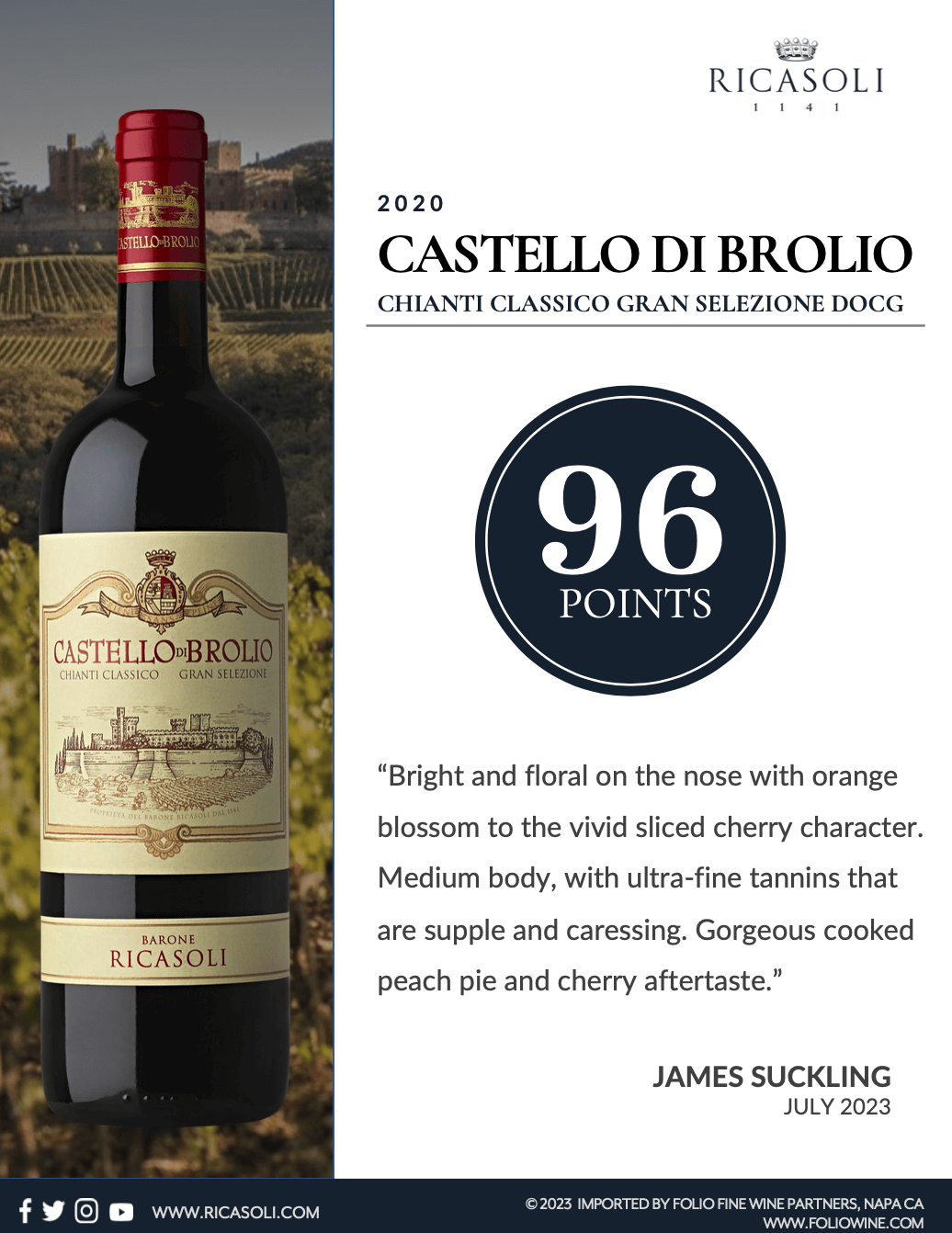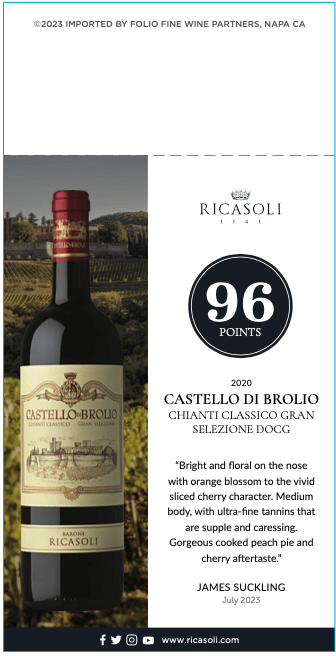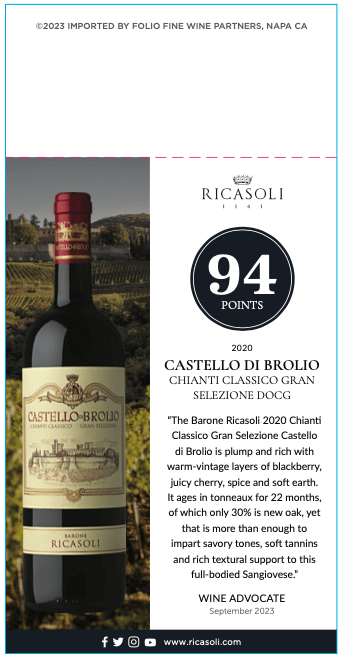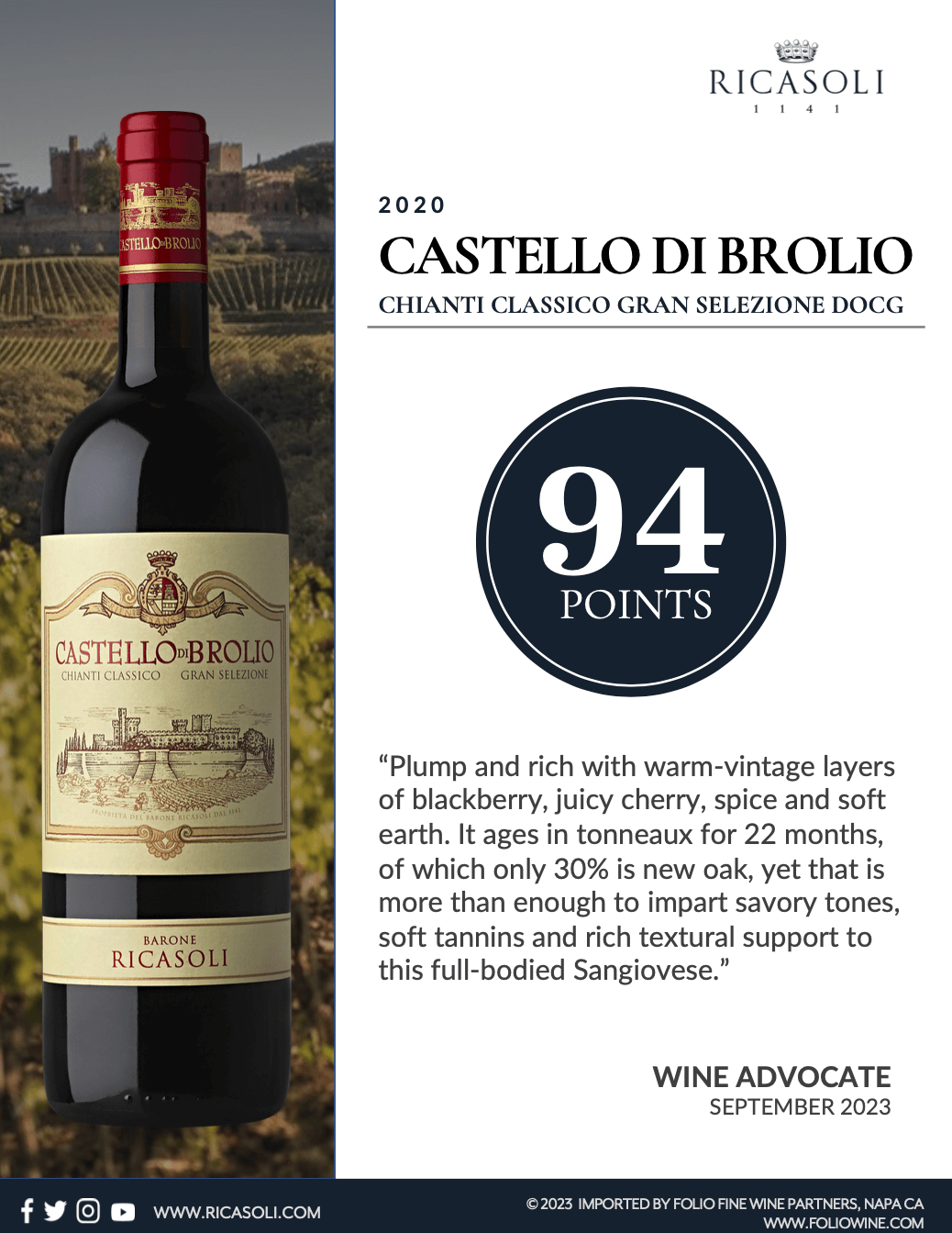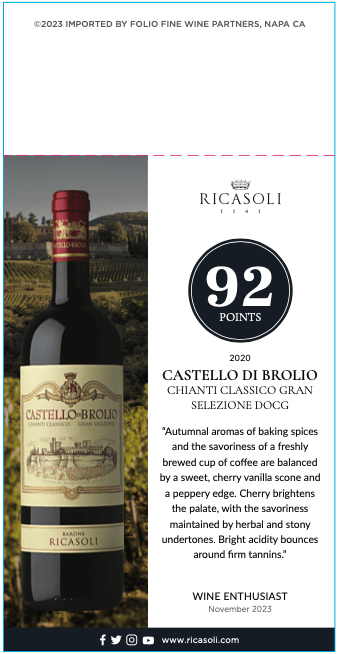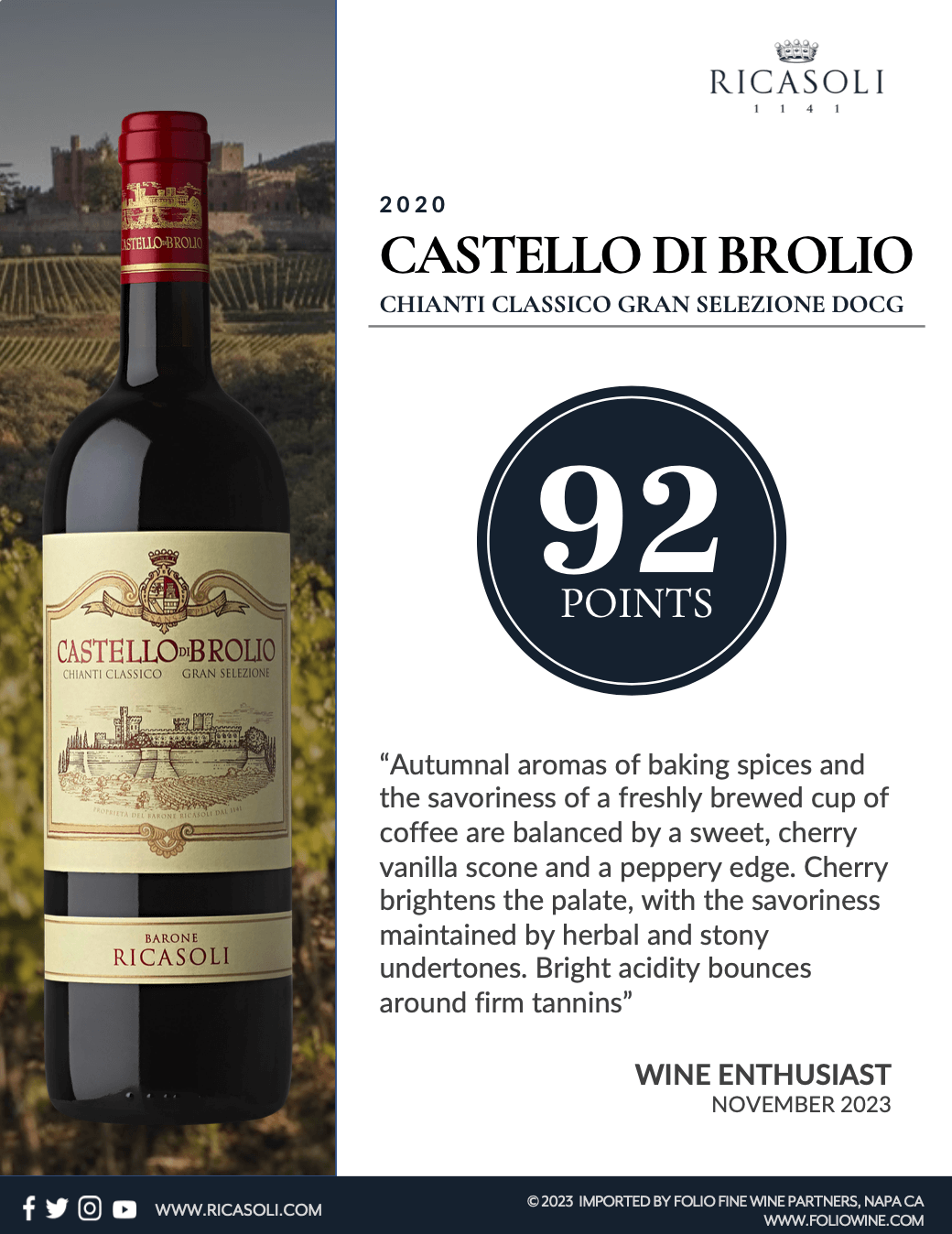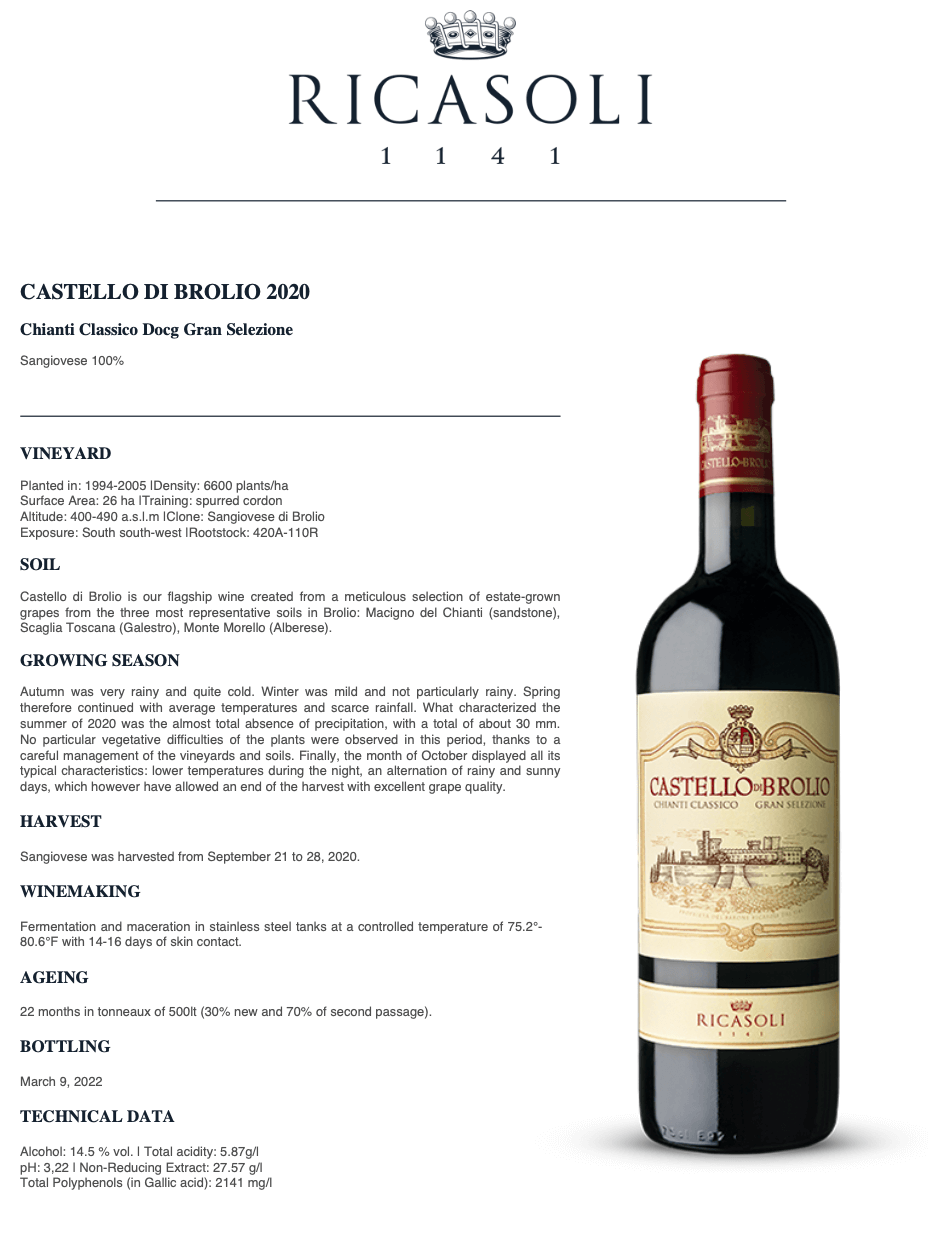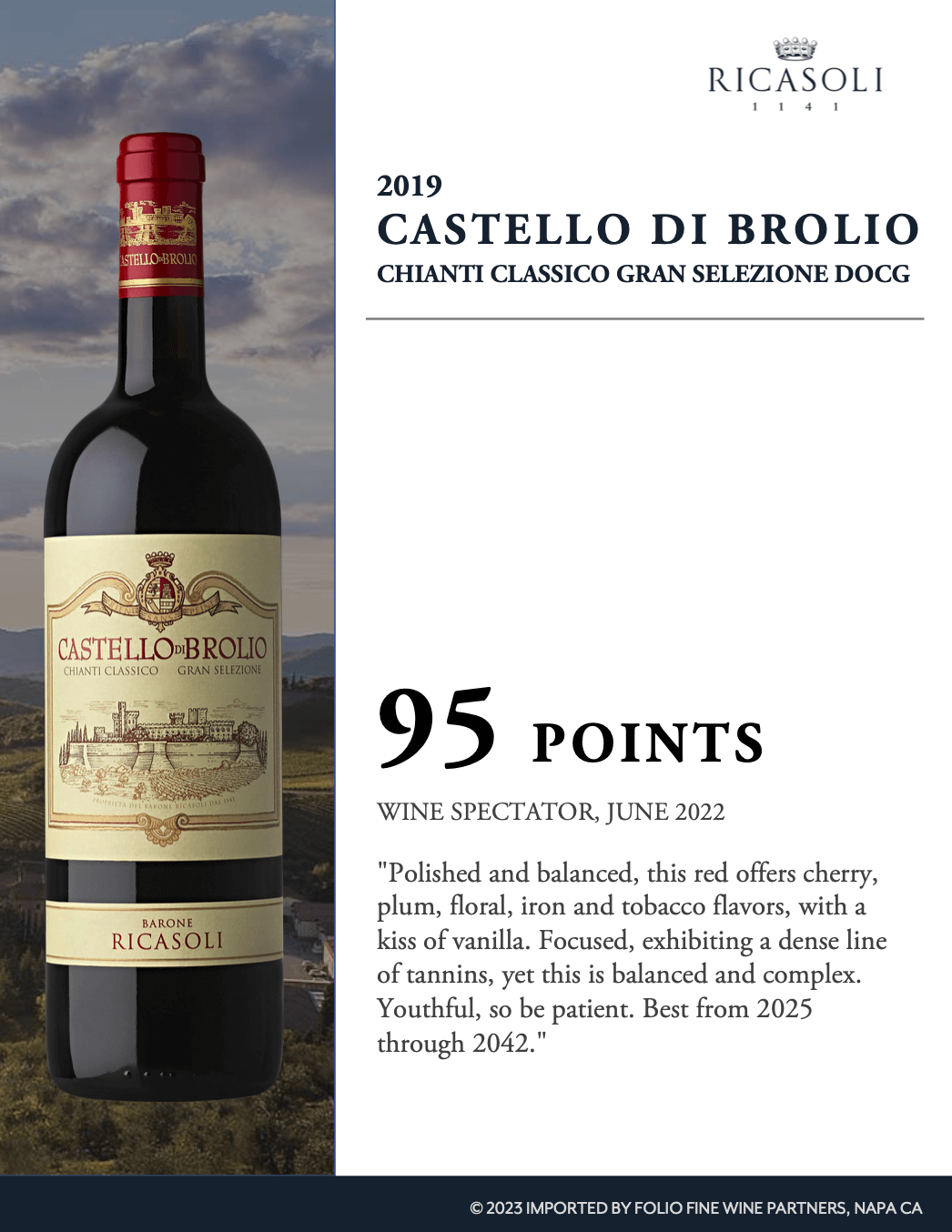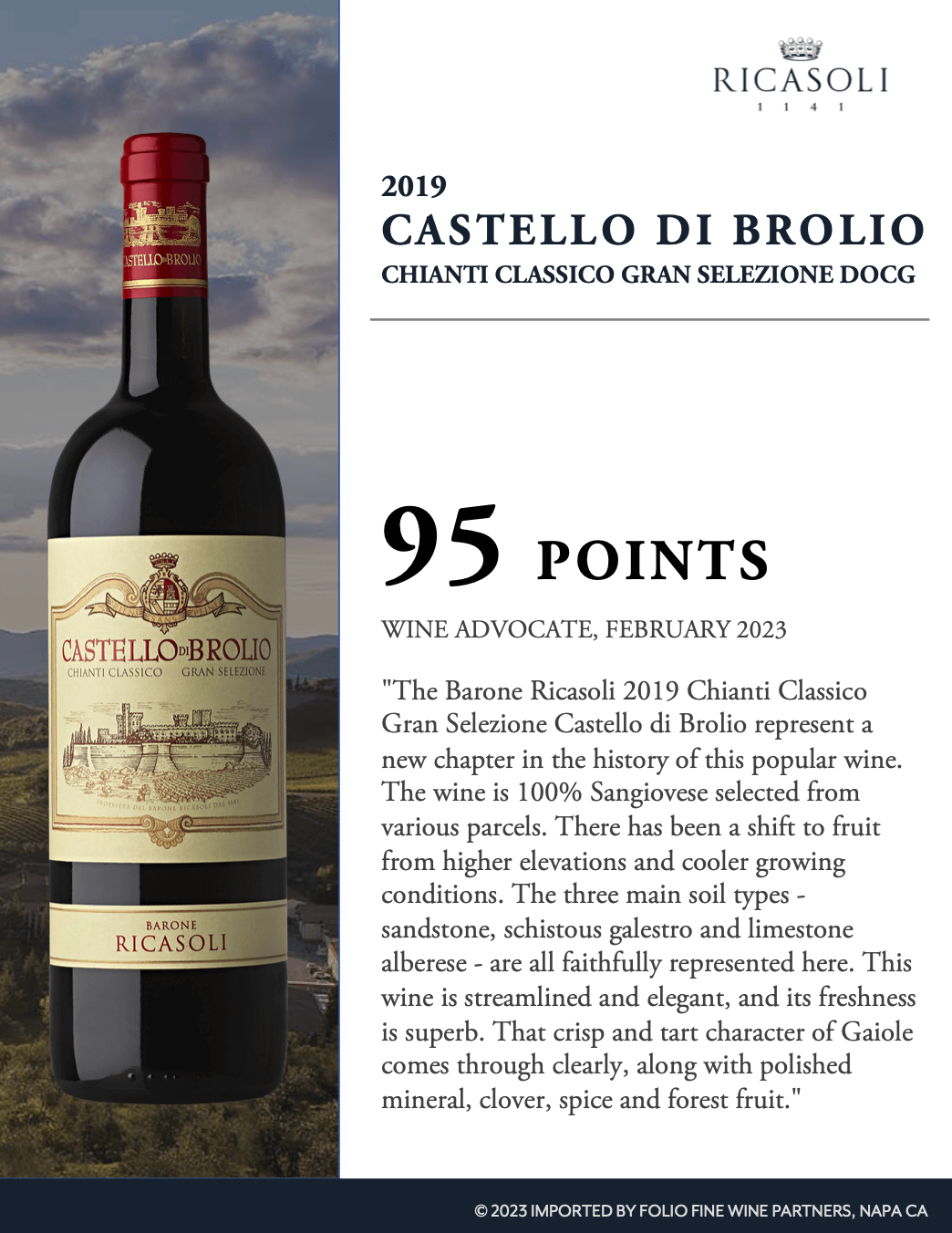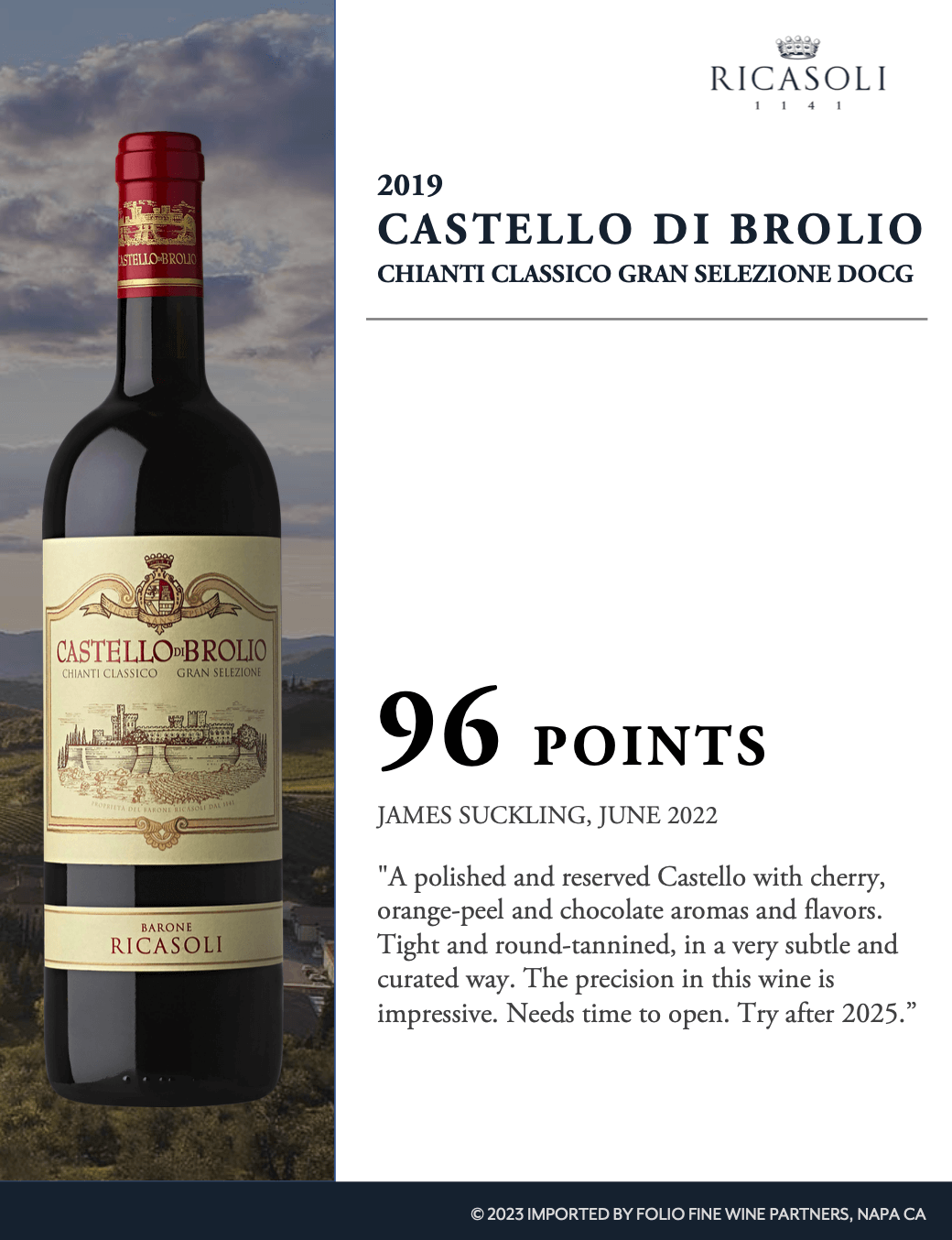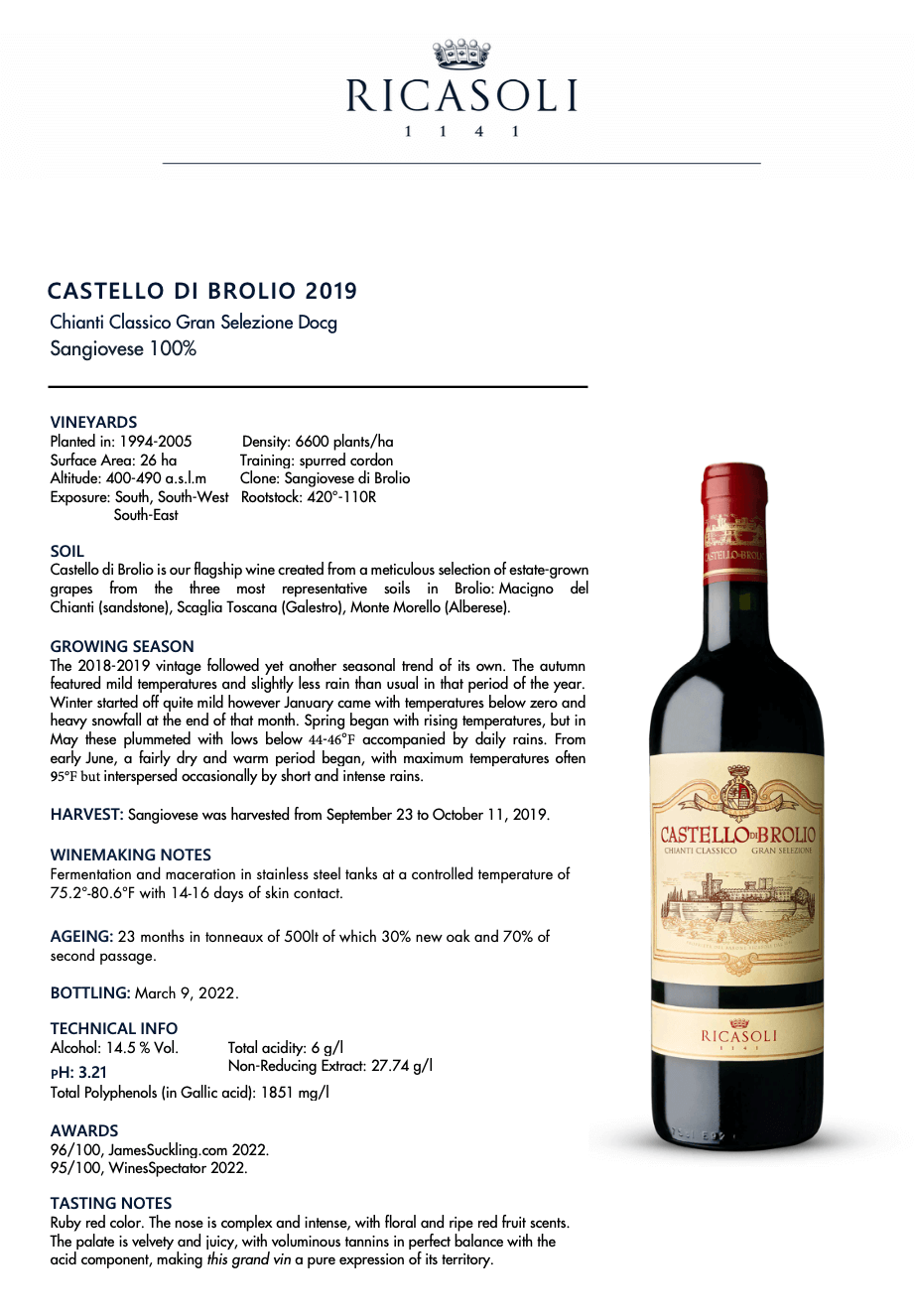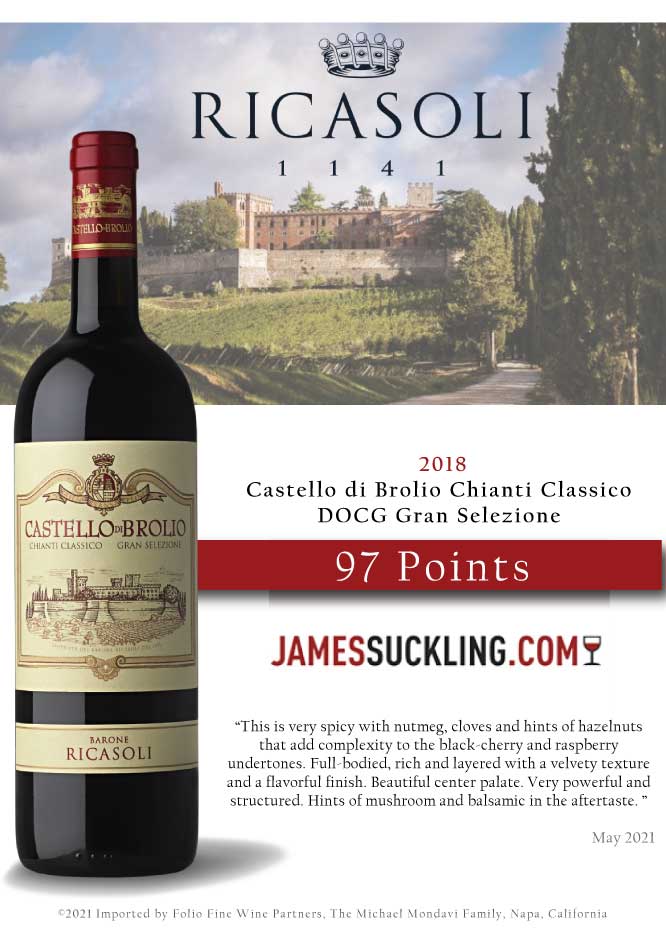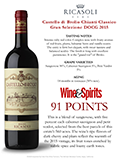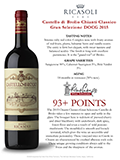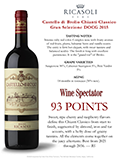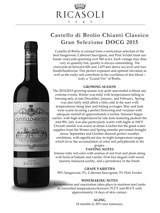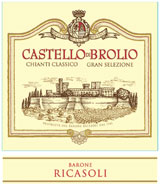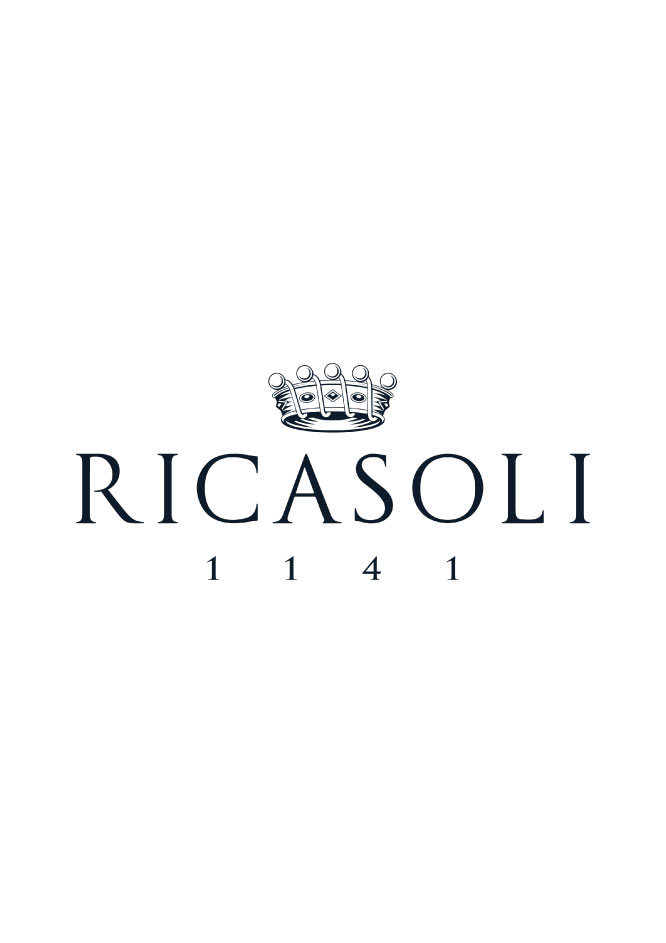




Ricasoli Castello di Brolio Chianti Classico Gran Selezione DOCG
Chianti Classico Gran Selezione DOCG, Tuscany, Italy
Tasting Notes
Ruby red color. The nose is complex and intense, with floral and ripe red fruit scents. The palate is velvety and juicy, with voluminous tannins in perfect balance with the acid component, making this grand vin a pure expression of its territory.
Vintage Notes
Autumn was very rainy and quite cold. Winter was mild and not particularly rainy. Spring therefore continued with average temperatures and scarce rainfall. What characterized the summer of 2020 was the almost total absence of precipitation, with a total of about 30 mm. No particular vegetative difficulties of the plants were observed in this period, thanks to a careful management of the vineyards and soils. Finally, the month of October displayed all its typical characteristics: lower temperatures during the night, an alternation of rainy and sunny days, which however have allowed an end of the harvest with excellent grape quality.
Harvest Notes
Sangiovese was harvested from September 23 to September 21-28, 2020.
Winemaking Notes
Fermentation and maceration in stainless steel tanks at a controlled temperature of 75.2°-80.6°F with 14-16 days of skin contact. 23 months in tonneaux of 500lt of which 30% new oak and 70% of second passage.
Vineyard Notes
Planted in: 1994-2005 Density: 6600 plants/ha Surface Area: 26 ha Training: spurred cordon Altitude: 400-490 a.s.l.m Clone: Sangiovese di Brolio Exposure: South, South-West, South-East Rootstock: 420°-110R
Technical Info
Varietal: 100% Sangiovese
Alcohol: 14.5%
Total acidity: 5.87 g/l
PH: 3.22
Non-Reducing Extract: 27.57 g/l
Total Polyphenols (in Gallic acid): 2141 mg/l
Tasting Notes
Ruby red color. The nose is complex and intense, with floral and ripe red fruit scents. The palate is velvety and juicy, with voluminous tannins in perfect balance with the acid component, making this grand vin a pure expression of its territory.
Vintage Notes
The 2018-2019 vintage followed yet another seasonal trend of its own. The autumn featured mild temperatures and slightly less rain than usual in that period of the year. Winter started off quite mild however January came with temperatures below zero and heavy snowfall at the end of that month. Spring began with rising temperatures, but in May these plummeted with lows below 44-46°F accompanied by daily rains. From early June, a fairly dry and warm period began, with maximum temperatures often 95°F but interspersed occasionally by short and intense rains.
Harvest Notes
Sangiovese was harvested from September 23 to October 11, 2019.
Winemaking Notes
Fermentation and maceration in stainless steel tanks at a controlled temperature of 75.2°-80.6°F with 14-16 days of skin contact. 23 months in tonneaux of 500lt of which 30% new oak and 70% of second passage.
Vineyard Notes
Planted in: 1994-2005 Density: 6600 plants/ha Surface Area: 26 ha Training: spurred cordon Altitude: 400-490 a.s.l.m Clone: Sangiovese di Brolio Exposure: South, South-West, South-East Rootstock: 420°-110R
Technical Info
Varietal: 100% Sangiovese
Alcohol: 14.5%
Total acidity: 6 g/l
PH: 3.21
Non-Reducing Extract: 27.74 g/l
Total Polyphenols (in Gallic acid): 1851 mg/l
Tasting Notes
Intense ruby red color with aromas of red fruit and plum along with hints of balsam and vanilla. Firm but elegant with sweet tannins, balanced acidity, and a persistence in the finish.
Vintage Notes
Overall, we can state that 2018 was a complex harvest due to the climate trends, which tended to be more humid than average in the past, but with excellent summer temperatures and a very dry period in the months of September and October.
Winemaking Notes
Fermentation and maceration in stainless steel tanks at a controlled temperature of 75.2°-80.6°F with 14-16 days of skin contact.
Technical Info
Alcohol: 14% Vol
Total acidity: 6.22 g/L
PH: 3.30
Non-Reducing Extract: 27.69 g/L
Total Polyphenols (in Gallic acid): 2066 mg/L
Tasting Notes
Intense ruby red color with aromas of red fruit and plum along with hints of balsam and vanilla. Firm but elegant with sweet tannins, balanced acidity, and a persistence in the finish.
Vintage Notes
The autumn and winter were very mild this year, with below-freezing temperatures only in part of January. In the spring, temperatures were average, with the end of May and early June hot but humid. This diminished the fruit set causing a thinning effect in the clusters that was good for the Sangiovese. Two hailstorms at the end of May also led to the loss of flowers, thus reducing per-plant growth. Summer was hot and dry. End-July and Mid-August rains gave some relief to the plants, helping them during the period of veraison. Harvest began in early September, with temperatures mid-to-high for that period of the year during the day and a drop of as much as 50-60°F at nights, favoring the accumulation of phenolic compounds.
Winemaking Notes
Fermentation and maceration takes place in stainless steel tanks at controlled temperatures between 75.2°F and 80.6°F with approximately 14-16 days of skin contact.
Technical Info
95% Sangiovese, 5% Cabernet Sauvignon
Tasting Notes
Intense ruby red color with aromas of red fruit and plum along with hints of balsam and vanilla. Firm but elegant with sweet tannins, balanced acidity, and a persistence in the finish.
Vintage Notes
The 2014/2015 growing season was quite uneventful without any extreme events. Winter was mild with temperatures falling to freezing only at late-December, January, and February. Spring was also fairly mild albeit a little cold at the start with temperatures rising later and hitting averages. May and June were warm favoring a perfect flowering and veraison with adequate rainfall of approximately 6 inches. Summer began earlier, with high temperatures by late-June featuring peaksin the mid-90s. July was also particularly warm with highs at 104°F. Overall rainfall was scarce at about 4 inches but the good water supplies from the Winter and Spring months prevented drought stress. September and October showed perfect weather conditions, with significant day-to-night temperature ranges which favor the accumulation of color and polyphenols in the grapes.
Winemaking Notes
Fermentation and maceration takes place in stainless steel tanks at controlled temperatures between 75.2°F and 80.6°F with approximately 14 days of skin contact.
Technical Info
90% Sangiovese, 5%, Cabernet Sauvignon, 5% Petit Verdot
 Back To Menu
Back To Menu

